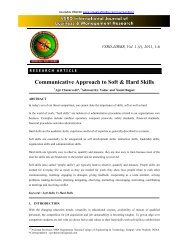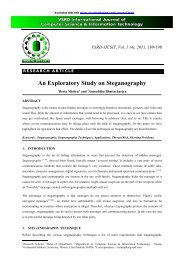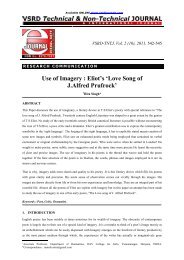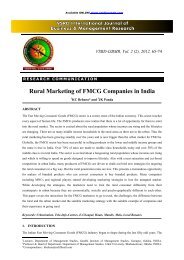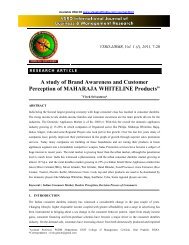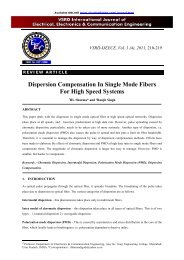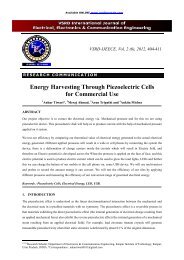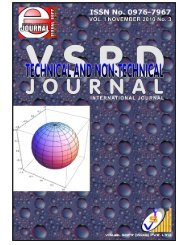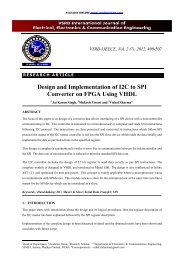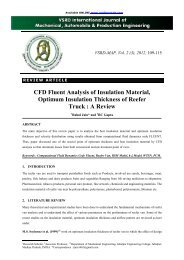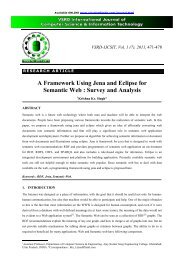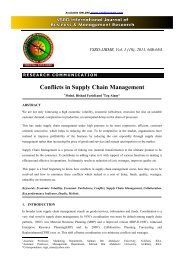Application of Combined Integral Equation for Electromagnetic ...
Application of Combined Integral Equation for Electromagnetic ...
Application of Combined Integral Equation for Electromagnetic ...
You also want an ePaper? Increase the reach of your titles
YUMPU automatically turns print PDFs into web optimized ePapers that Google loves.
Available ONLINE www.vsrdjournals.com<br />
R E S E A R C H C O M M U N II C A T II O N<br />
____________________________<br />
VSRD-TNTJ, Vol. 3 (2), 2012, 69-78<br />
<strong>Application</strong> <strong>of</strong> <strong>Combined</strong> <strong>Integral</strong> <strong>Equation</strong> <strong>for</strong><br />
<strong>Electromagnetic</strong> Spreading Problems<br />
ABSTRACT<br />
1 Nazneen Khan* and 2 Pankaj Singh<br />
In this paper we derive a novel CFIE <strong>for</strong>mulation in which the electric and magnetic field integral equations<br />
(EFIE and MFIE) are combined in the usual manner outside <strong>of</strong> the object. Inside the object CFIE is composed<br />
by changing the roles <strong>of</strong> EFIE and MFIE. Solution <strong>of</strong> combined field integral equation (CFIE) <strong>for</strong><br />
electromagnetic spreading by an arbitrary shaped dielectric object is analyzed and described in brief after<br />
completely study. In addition, we consider numerical evaluation <strong>of</strong> the singular impedance matrix elements with<br />
the singularity extraction technique. Numerically stable electric field integral equations (EFIE) are presented <strong>for</strong><br />
electromagnetic scattering problems that may include both electrically small geometrically complex and<br />
electrically large regions. A reduced integrand is achieved by implementing quasi-static assumptions in the<br />
electrically small regions, full-wave methods in the electrically large regions, and applying appropriate coupling<br />
relations between the regions. Use <strong>of</strong> the method provides computational efficiency as well as insight into the<br />
conditions under which the electromagnetic fields within electrically small regions <strong>of</strong> the problem can be<br />
assumed to be primarily capacitive or inductive in nature. The theoretical development <strong>of</strong> the method is<br />
highlighted in this communication and then applied to examples <strong>of</strong> electrically small, inductively-loaded, and<br />
capacitive-loaded monopole antennas. The accuracy <strong>of</strong> the results is verified with two independent methods.<br />
Here we present a new <strong>for</strong>mulation using the time-domain electric field integral equation TD - EFIE to obtain a<br />
transient scattering response from arbitrarily shaped conducting bodies.<br />
In the solution <strong>of</strong> the magnetic field integral equation (MFIE) by the method <strong>of</strong> moments (MOM) on planar<br />
triangulations, singularities arise both in the inner integrals on the basis functions and also in the outer integrals<br />
on the testing functions. A singularity-extraction method is introduced <strong>for</strong> the efficient and accurate computation<br />
<strong>of</strong> the outer integrals, similar to the way Inner-integral singularities are handled.<br />
In this paper a solution <strong>of</strong> combined field integral equation (CFIE) <strong>for</strong> electromagnetic scattering by an arbitrary<br />
shaped dielectric object is studied. We derive a novel CFIE <strong>for</strong>mulation in which the electric and magnetic field<br />
integral equations (EFIE and MFIE) are combined in the usual manner outside the object. Inside the object CFIE<br />
1 Research Scholar, Department <strong>of</strong> Mathematics, JJTU, Jaipur, Rajasthan, INDIA.<br />
2 Pr<strong>of</strong>essor, Department <strong>of</strong> Mathematics, Kanpur Institute <strong>of</strong> Technology, Kanpur, Uttar Pradesh, INDIA.<br />
*Correspondence : knaznnen.khan786@gmail.com
Nazneen Khan et al / VSRD Technical & Non-Technical Journal Vol. 3 (2), 2012<br />
is composed by changing the roles <strong>of</strong> EFIE and MFIE. In addition, we consider numerical evaluation <strong>of</strong> the<br />
singular impedance matrix elements with the singularity extraction technique.<br />
Keywords: Singular Impedance Matrix, Electric Field Interpretation, Magnetic Field Integration <strong>Equation</strong>,<br />
<strong>Combined</strong> Field Integration <strong>Equation</strong>, Time Difference EFIE.<br />
1. INTRODUCTION<br />
There are several alternative ways to <strong>for</strong>mulate boundary integral equations <strong>for</strong> electromagnetic scattering by<br />
homogeneous dielectric bodies. The most widely applied <strong>for</strong>mulations are the PMCHW <strong>for</strong>mulation and the<br />
combined field <strong>for</strong>mulation (CFIE) [2], [3]. In [3], the authors observed that if the RWG functions [4] are taken<br />
as both basis and test functions in the method <strong>of</strong> moment’s solution <strong>of</strong> the CFIE, the traditional <strong>for</strong>m <strong>of</strong> CFIE<br />
leads to a very unstable solution. The reason is that only the electric surface current is well tested. As a remedy<br />
they suggest to test by both RWG and n*RWG functions, where n is the outer unit normal <strong>of</strong> the object. The<br />
most convenient <strong>for</strong>mulation was obtained when the electric field part <strong>of</strong> CFIE is tested by RWG + n*RWG<br />
functions and the magnetic field part is tested by RWG functions. This <strong>for</strong>mulation was named a TENENH<br />
<strong>for</strong>mulation.<br />
An application <strong>of</strong> the method <strong>of</strong> moments with Galerkin's method to solve electromagnetic integral equations<br />
requires calculation <strong>of</strong> double integrals with singular kernels. Singular terms can be considered either by<br />
numerical methods (e.g. Duffy's method) or by singularity extraction technique [5].<br />
In many cases numerical accuracy <strong>of</strong> the singular integrals is crucial <strong>for</strong> having an efficient algorithm, especially<br />
in the near field computing. The aim is <strong>of</strong> this paper is tw<strong>of</strong>old. Firstly we present a new type <strong>of</strong> CFIE<br />
<strong>for</strong>mulation. In this <strong>for</strong>mulation we use traditional CFIE outside the object but inside the object the electric and<br />
magnetic field integral equations (EFIE and MFIE) are combined by changing their roles. This <strong>for</strong>mulation<br />
gives TENH <strong>for</strong>mulation outside the object and NETH <strong>for</strong>mulation inside the object. This <strong>for</strong>mulation has<br />
several nice properties: It is <strong>for</strong>mally simpler that the TENENH <strong>for</strong>mulation, it is free <strong>of</strong> interior resonances and<br />
it gives a stable solution. Secondly we present accurate and robust methods to evaluate singular integrals<br />
appearing in the CFIE <strong>for</strong>mulations, when the integral equations are tested by both RWG and n*RWG functions<br />
and the basic functions are RWG functions.<br />
Our method is based on the singularity extracting technique. First we extract enough terms from the singular<br />
kernel so that the remaining function is at least once continuously differentiable and allows numerical<br />
integration. In evaluating the gradient <strong>of</strong> the Green's function the accuracy is easily lost although the singularity<br />
has been extracted. The reason is that in computing the impedance matrix elements we have to consider double<br />
integrals and the remaining outer integral may still have a logarithmical singularity. There<strong>for</strong>e, in the terms<br />
including the gradient we modify the integrand and change the order <strong>of</strong> integration. By these modifications we<br />
can integrate all singular functions in closed <strong>for</strong>m and the remaining terms are regular enough <strong>for</strong> numerical<br />
integration. Thus, Duffy's trans<strong>for</strong>mation or any other special integration quadratures are not required.<br />
Developed <strong>for</strong>mulas and <strong>for</strong>mulations are verified by considering numerical examples.<br />
Page 70 <strong>of</strong> 78
2. EFIE INTERPRETATION<br />
Nazneen Khan et al / VSRD Technical & Non-Technical Journal Vol. 3 (2), 2012<br />
The EFIE describes a radiated field E given a set <strong>of</strong> sources J, and as such it is the fundamental equation used<br />
in antenna analysis and design. It is a very general relationship that can be used to compute the radiated field <strong>of</strong><br />
any sort <strong>of</strong> antenna once the current distribution on it is known. The most important aspect <strong>of</strong> the EFIE is that it<br />
allows us to solve the radiation/scattering problem in an unbounded region, or one whose boundary is located<br />
at infinity. For closed surfaces it is possible to use the Magnetic Field <strong>Integral</strong> <strong>Equation</strong> or the <strong>Combined</strong> Field<br />
<strong>Integral</strong> <strong>Equation</strong>, both <strong>of</strong> which result in a set <strong>of</strong> equations with improved condition number compared to the<br />
EFIE. However, the MFIE and CFIE can still contain resonances.<br />
In scattering problems, it is desirable to determine an unknown scattered field Es that is due to a known incident<br />
field Ei Un<strong>for</strong>tunately; the EFIE relates the scattered field to J, not the incident field, so we do not know<br />
what J is. This sort <strong>of</strong> problem can be solved by imposing the boundary conditions on the incident and scattered<br />
field, allowing one to write the EFIE in terms <strong>of</strong> Ei and J alone. Once this has been done, the integral equation<br />
can then be solved by a numerical technique appropriate to integral equations such as the method <strong>of</strong> moments.<br />
3. GENERAL TD – EFIE<br />
Let S denote a perfectly conducting surface, which may be closed or open, illuminated by a transient<br />
electromagnetic wave. This incident wave induces a surface current J (r, t) on S which then reradiates. We have<br />
E s (J)= - ∂A / ∂t - φ …(1)<br />
where A and φ are the magnetic vector potential and the electric scalar potential given by<br />
A (r, t) = μ/4π ∫s J (r, τ)/R dS` …(2)<br />
Φ (r, t) = 1/4πε ∫s q (r`, τ)/R dS` …(3)<br />
τ = t - (R/c) …(4)<br />
R = | r – r` | …(5)<br />
and where μ and ε are the permeability and permittivity <strong>of</strong> space, c is the velocity <strong>of</strong> wave propagation in that<br />
space, and r and r` are the arbitrarily located observation point and source point. The surface-charge density q is<br />
related to the surface divergence <strong>of</strong> J through the equation <strong>of</strong> continuity:<br />
Utilizing (6), we have from (3)<br />
t<br />
. J (r, t) = - ∂q (r, t)/ ∂t or q (r, t) = - ∫0 . J (r, t`) dt` …(6)<br />
τ<br />
Φ (r, t) = - 1/4πε ∫s ∫0 ` . J (r, t`)/R dt`/dS` …(7)<br />
Since the total tangential electric field is zero on the conducting surface <strong>for</strong> all times, we have<br />
[E i + E s (J)]tan – 0, r € S …(8)<br />
Page 71 <strong>of</strong> 78
Nazneen Khan et al / VSRD Technical & Non-Technical Journal Vol. 3 (2), 2012<br />
And [∂A/∂t + Φ]tan = [E i ]tan …(9)<br />
where E i is the incident electric field on the scattered and the subscript ‘‘tan’’ denotes the tangential component.<br />
<strong>Equation</strong> (9) with (2) and (7) constitutes a TD-EFIE from which the unknown current J (r, t) may be determined.<br />
4. THE MAGNETIC FIELD INTEGRAL EQUATION<br />
Let an electromagnetic field with angular frequency ω be incident upon an object with a surface S <strong>of</strong> arbitrary<br />
shape. For perfectly-conducting material, all induced current is surface current i(r) . The magnetic field B(r) at<br />
point r can then be written as<br />
B(r) = B (r)inc – µ0/4π ∫dS` i(r`) * g (r, r`), (r <strong>of</strong>f S) …(1)<br />
with B(r)inc the given, but further arbitrary, incident field. The second term on the right hand side equals the<br />
magnetic field generated by the current, with<br />
g (r – r`) = e ik |r – r`|<br />
0 / |r – r`|, k0 = ω/c, …(2)<br />
the free-space Green's function <strong>for</strong> the Helmholtz equation. The integral in Eq. (1) runs over the surface S, and<br />
r' indicates a point in S. It is essential that the field point r is not in S, since ∇g(r − r') has a singularity <strong>for</strong> r'→r.<br />
Let us now consider the field points r+ and r- , just outside and inside the material, respectively, and near the<br />
point r in S. with nˆ(r) the unit normal vector on S at r, directed from the medium into the vacuum, we can<br />
then write r = r ± ε nˆ(r) ± with ε small. As long as ε is finite, Eq. (2) applies with r replaced by r± . For the<br />
integral over S, we leave out a circle with radius δ around r, and then let ε approach zero. In the limit ε → 0 ,<br />
there is a finite contribution from the singularity at r'= r , and this contribution remains finite <strong>for</strong> δ →0 . The<br />
result <strong>of</strong> this procedure is [20] :<br />
B (r±) = B(r)inc ±1/2 µ0 I(r) * n(r) – µ0 / 4π .p∫ dS` i(r`) * g (r – r`) (r in S) …(3)<br />
Expressing the total magnetic field just outside and inside the material as the sum <strong>of</strong> the incident field at r and<br />
the contribution from the current density i(r) . The integral over S is now a Cauchy Principal Value integral, and<br />
the second term on the right-hand side is the finite contribution from the singularity. Taking the difference<br />
between the plus and minus equations yields<br />
B(r+) – B(r-) = µ0 i(r) *n(r) …(4)<br />
Which is the usual boundary condition <strong>for</strong> an interface carrying a surface current density i(r) .<br />
When the material is a perfect conductor, the electromagnetic field inside vanishes. In particular at the point r−<br />
we have B(r−)=0 and Eq. (3) with the lower sign becomes<br />
I(r) + 1/2π. n(r) * P ∫ dS i(r`) * g(r – r`) =2/µ0. n(r) * B(r)inc …(5)<br />
after taking the cross product with nˆ(r) . This integral equation <strong>for</strong> the unknown current density i(r) is the<br />
Magnetic Field <strong>Integral</strong> <strong>Equation</strong>, originally due to Maue [21]. After solving Eq. (5) <strong>for</strong> i(r), if possible, the<br />
Page 72 <strong>of</strong> 78
Nazneen Khan et al / VSRD Technical & Non-Technical Journal Vol. 3 (2), 2012<br />
magnetic field at a field point r outside the material follows by integration from Eq. (1). For any r inside the<br />
medium, the term with the integral in Eq. (1) should cancel exactly the incident field inc B(r) when i(r) is a<br />
solution <strong>of</strong> Eq. (5). <strong>Equation</strong> (4) becomes<br />
B(r+) = µ0 i(r) *n(r) …(6)<br />
<strong>for</strong> a perfect conductor, and the cross product with nˆ(r) gives<br />
i(r) = 1/µ0. n(r) * B(r+) …(7)<br />
since i(r) is in the tangent plane <strong>of</strong> S at r.<br />
5. CFIE<br />
The combined-field integral equation (CFIE) is a linear combination <strong>of</strong> the H-field and the E-field integral<br />
equations. Previously, the weighting parameter <strong>of</strong> the E-field equation in the CFIE had been assumed constant<br />
along the generating curve <strong>of</strong> the body <strong>of</strong> revolution. However, it is shown that the weighting parameter can<br />
take a variable distribution along the generating curve or on a part <strong>of</strong> it only. In the latter case, a reduction in the<br />
computational time <strong>of</strong> 40-50% is achieved.<br />
6. FORMULATION<br />
Consider the problem <strong>of</strong> electromagnetic scattering by a homogeneous dielectric body D in IR 3 . Let S denote the<br />
surface <strong>of</strong> D and let n denote the outer unit normal <strong>of</strong> D. The traditional <strong>for</strong>m <strong>of</strong> CFIE reads [2].<br />
p EFIE + q n * MFIE …(1)<br />
Where p = α; q = (1-α) η, 0 < η < 1; η= Sqrt. μ0/ε0 and EFIE and MFIE denote the electric and magnetic field<br />
integral equations. Another possible CFIE <strong>for</strong>mulation is to combine EFIE and MFIE as<br />
p n* EFIE + q MFIE: …(2)<br />
Using RWG functions [4] as both basis and test functions to discretize (1) and (2), gives the following equations<br />
p∫s fm. EFIE dS - q∫s (n * fm) MFIE dS,<br />
- p∫s (n * fm). EFIE dS + q∫s fm MFIE dS,<br />
<strong>for</strong> all m = 1------N, where fm denotes an RWG function. <strong>Equation</strong> (1) gives a TENH <strong>for</strong>mulation and (2) gives<br />
a NETH <strong>for</strong>mulation [3]. As pointed out in [3] none <strong>of</strong> these two equations lead to a stable solution. As a<br />
remedy, in [3] the authors suggest to test EFIE by fm +n * fm. The resulting <strong>for</strong>mulations are called TENENH<br />
and TENETH, respectively. However, the testing procedure can be simplified if EFIE and MFIE are combined<br />
as follows:<br />
a EFIE-O + q n * MFIE-O<br />
p n * EFIE-I + q MFIE-I: …(3)<br />
Page 73 <strong>of</strong> 78
Nazneen Khan et al / VSRD Technical & Non-Technical Journal Vol. 3 (2), 2012<br />
Here O stands <strong>for</strong> outside D and I stand <strong>for</strong> inside D. This <strong>for</strong>mulation gives TENH <strong>for</strong>mulation outside D and<br />
NETH <strong>for</strong>mulation inside D, so called TENH/NETH <strong>for</strong>mulation. In TENH/NETH <strong>for</strong>mulation the electric<br />
current is well tested by the TENH equation outside D and the magnetic current is well tested by the NETH<br />
equation inside D. Thus, both currents will be well tested. Furthermore, because both TENH and NETH<br />
<strong>for</strong>mulations are free <strong>of</strong> interior resonances [3] also their combination shares the same property.<br />
7. NUMERICAL IMPLEMENTATION<br />
Let fn denote an RWG function with the support Sn and let gm denote an RWG function or p n * RWG function<br />
with the support Sm. An application <strong>of</strong> the method <strong>of</strong> moments to solve CFIEs (1) and (2) by the RWG<br />
functions requires calculation <strong>of</strong> the following double integrals [3].<br />
I1 := ∫sm gm(r). ∫sn G(r; r`) `s .fn(r`) dS` dS,<br />
I2 := ∫sm gm(r). ∫sn G(r; r`) fn(r`) dS` dS,<br />
I3 := ∫sm gm(r). ∫sn G(r; r`) *fn(r`) dS` dS,<br />
I4 := ∫sm gm(r). (n (r)*fn(r`)) dS,<br />
Where G is the free space Green's function.<br />
If the supports <strong>of</strong> gm and fn are far away from each other, the above integrals are regular and they can be<br />
calculated numerically. Let us consider the case when Sm and Sn are close to each other or they have common<br />
points and let R = | r – r`|. Because the RWG functions are composed on a triangle pair it suffices to consider<br />
calculation <strong>of</strong> the above integrals over single triangles. We begin by modifying integral I1 as<br />
{ I 1 = -∫Tm s f m(r). ∫Tn G(r; r`) `s .f n(r`) dS` dS }, if g m = f m<br />
{I 1= ∫ ∂Tm m (r) .( n(r)*. f m(r)) ∫Tn G(r; r`) `s .f n(r`) dS` dl }, if g m = n * f m,<br />
Where m is the unit vector <strong>of</strong> the boundary ∂Tm <strong>of</strong> Tm pointing into the exterior <strong>of</strong> Tm. We may conclude the<br />
following:<br />
� <strong>Integral</strong>s I1 and I2 have a singularity <strong>of</strong> order 1/R.<br />
� After evaluating the inner integrals <strong>of</strong> I1 and I2 with respect to r`, the outer integral with respect to r is<br />
regular.<br />
� <strong>Integral</strong> I3 vanishes if Sm and Sn are on the same plane.<br />
� If Sm and Sn are not in the same plane, integrand <strong>of</strong> I3 has a singularity <strong>of</strong> order 1=R 2 .<br />
� If Sm and Sn are not in the same plane, after evaluated the inner integral <strong>of</strong> I3, the outer integral may still<br />
have a logarithmic singularity.<br />
� <strong>Integral</strong> I4 is regular.<br />
Page 74 <strong>of</strong> 78
Nazneen Khan et al / VSRD Technical & Non-Technical Journal Vol. 3 (2), 2012<br />
Thereafter integrals I1 and I2 are calculated by extracting two terms from the Green's function<br />
G(r, r`) = (G(r, r`) – 1/4πR+k 2 R/8π) + 1/4πR - k 2 R/8π.<br />
Here the term in the brackets has two continuous derivatives and a standard integration routine on triangles such<br />
as the Gaussian quadrature gives accurate results. The last two terms on the right hand side (RHS) can be<br />
integrated in closed <strong>for</strong>m [4], [5]. Consider next term I3 with an RWG testing function. Using the same idea as<br />
above, we write [6]<br />
G(r; r`) = (G(r, r`) – 1/4πR + k 2 R/8π) + 1/4π 1/R - k / 8π R …(4)<br />
The first term on the RHS has a continuous derivative and there<strong>for</strong>e, it can be integrated numerically. The<br />
extracted terms, i.e. the second and third terms on the RHS <strong>of</strong> (4), can be integrated analytically over Tn using<br />
the <strong>for</strong>mulas presented in [7] and [5]. Thereafter, the last term can be integrated numerically over Tm, because<br />
the integrand is regular. The problem is to integrate the second term over Tm. Let us consider this term more<br />
carefully.<br />
Since an RWG function is given as +L / (2A) (r - p) [3], where L and A are the length <strong>of</strong> an edge and the area <strong>of</strong><br />
a triangle, it suffices to consider the following singular double integral<br />
Cmn ∫Tm (r - p) . ∫Tn G0(r, r`) *(r`- q) dS` dS, ….(5)<br />
Where G0 = 1- (4πR), Cmn = +LmLn = (4AmAn)<br />
and p and q are the free vertices <strong>of</strong> the test and basis triangles. We consider this integral in two parts by<br />
separating the normal and surface derivatives. Be<strong>for</strong>e applying analytical <strong>for</strong>mulas, we apply the Gauss<br />
divergence theorem to the surface gradient term and translate the integral over Tn into a line integral over the<br />
edges <strong>of</strong> Tn and then change the order <strong>of</strong> integration. This gives us the following integral [5]<br />
Cmn ∫∂Tn m (r`) . ∫Tm (r – p)/4πR dS dl` .<br />
Now the inner integral (with respect to r) is evaluated analytically and the outer integral is regular and allows<br />
numerical integration. Term I3 with an n*RWG testing function is considered by applying the same idea. More<br />
details are presented in [5].<br />
8. EXAMPLE<br />
In order to verify the stability <strong>of</strong> TENH/NETH <strong>for</strong>mulation, we consider a dielectric sphere with εr = 4, r = 1=k0;<br />
k0 = w sqrt. ε0 µ0 illuminated by an axially incident plane wave. The figures on the LHS <strong>of</strong> Figure -1 show the<br />
equivalent electric and magnetic surface current densities on the surface <strong>of</strong> a sphere. The results show a good<br />
agreement with the present method and the other methods. Next we study the accuracy <strong>of</strong> the developed<br />
integration routines. We consider singular integral (5) with Cmn = 4π in the case where Tm and Tn share an edge.<br />
We see that the Gaussian quadrature without extracting the singularity leads to a significant error (solid line with<br />
circles on the RHS <strong>of</strong> Figure 1).<br />
Page 75 <strong>of</strong> 78
Nazneen Khan et al / VSRD Technical & Non-Technical Journal Vol. 3 (2), 2012<br />
Electric Current<br />
Ө Degrees λ<br />
Magnetic Current Number <strong>of</strong> Points<br />
θ Degrees Number <strong>of</strong> points<br />
Figure 1<br />
Page 76 <strong>of</strong> 78
Nazneen Khan et al / VSRD Technical & Non-Technical Journal Vol. 3 (2), 2012<br />
Fig. 1: On the LHS is the electric and magnetic current densities on a dielectric sphere. The figure displays CFIE<br />
(TENH/NETH) solution (solid line with circles), PMCHW solution (dashed line) and analytical solutions (solid<br />
line). On the horizontal axis is the angle from the axis <strong>of</strong> the sphere. The figures on the RHS show the geometry<br />
and the integral (5) in the case where triangles Tm and Tn have a common edge. The value <strong>of</strong> the integral is<br />
computed with three methods: the method <strong>of</strong> this paper (solid line), traditional singularity extraction and<br />
Gaussian (dashed line), double Gaussian without singularly extraction (solid line with circles). Horizontal axis<br />
shows the number <strong>of</strong> integration points.<br />
9. REFERENCES<br />
[1] A. Friedman, Stochastic Differential <strong>Equation</strong>s and <strong>Application</strong>s, Vol. 1 and 2, Academic Press.<br />
[2] S.M. Rao and D.R. Wilton, \E-field, H-field, and combined field solution <strong>for</strong> arbitrarily shaped three<br />
dimensional dielectric bodies", <strong>Electromagnetic</strong>, vol. 10, pp. 407-421, 1990.<br />
[3] X-Q. Sheng, J-M. Jin, J. Song, W.C. Chew and C-C. Lu, \Solution <strong>of</strong> combined-field integral equation<br />
using multilevel fast multipole algorithm <strong>for</strong> scattering by homogeneous bodies", IEEE Trans. on Antennas<br />
and Propagation, vol. 46, pp. 1718 - 1726, 1998.<br />
[4] S.M. Rao, D.R. Wilton and A.W. Glisson, \<strong>Electromagnetic</strong> scattering by surfaces <strong>of</strong> arbitrary shape", IEEE<br />
Trans. Antennas and Propagation, vol. AP-30, pp. 409-418, 1982.<br />
[5] D.R. Wilton, S.M. Rao, A.W. Glisson, D.H. Schaubert, O.M. Al-Bundak and C.M. Butler, Potential<br />
integrals <strong>for</strong> uni<strong>for</strong>m and linear source distributions on polygonal and polyhedral domains, \IEEE Trans.<br />
Antennas and Propagation", Vol. AP-32, pp. 276-281, 1984.<br />
[6] P. Yla-Oijala and M. Taskinen, \Calculation <strong>of</strong> CFIE impedance matrix elements with RWG and n*RWG<br />
functions",<br />
[7] unpublished, 2001.<br />
[8] R.E. Hodges and Y. Rahmat-Samii, The evaluation <strong>of</strong> MFIE integrals with the use <strong>of</strong> vector triangle basis<br />
functions,<br />
[9] \Microwave and Optical Technology Letters", Vol. 14, pp. 9-14, 1997.<br />
[10] R.D. Graglia, On the numerical integration <strong>of</strong> the linear shape functions times the 3-D Green's function or<br />
its gradient on a plane triangle, \IEEE Trans. Antennas and Propagation", Vol. 41, pp. 1448-1455, 1993.<br />
[11] L. Arnold, Stochastic Differential <strong>Equation</strong>s: Theory and <strong>Application</strong>s, Wiley, 1974.<br />
[12] I. I. Gihman and A. V. Skorohod, Stochastic Differential <strong>Equation</strong>s, Springer, 1972.<br />
[13] K. E. Brenan, S. L. Campbell, and L. R. Petzold, Numerical Solution <strong>of</strong> Initial Value Problems in<br />
Di®erential-Algebraic <strong>Equation</strong>s, SIAM, Philadelphia, 1996.<br />
[14] L. F. Shampine, Numerical Solution <strong>of</strong> Ordinary Di®erential <strong>Equation</strong>s, Chap-man and Hall, New York,<br />
1994.<br />
[15] L. F. Shampine and M. W. Reichelt, The MATLAB ODE suite, SIAM Journal on Scienti¯c Computing, 18<br />
(1997), pp. 1{22.<br />
[16] C. Sparrow, The Lorenz <strong>Equation</strong>s: Bifurcations, Chaos, and Strange Attrac-tors, Springer-Verlag, New<br />
York, 1982.<br />
[17] J. C. G. Walker, Numerical Adventures with Geochemical Cycles, Ox<strong>for</strong>d University Press, New York,<br />
1991. 53<br />
[18] B.H. Jung and T.K. Sarkar, Time-domain electric-field integral equation with central finite difference, Microwave Opt Technol Lett 31<br />
Page 77 <strong>of</strong> 78
(2001), 429–435.<br />
Nazneen Khan et al / VSRD Technical & Non-Technical Journal Vol. 3 (2), 2012<br />
[19] Ö. Ergül and L. Gürel, “Investigation <strong>of</strong> the inaccuracy <strong>of</strong> the MFIE discretized with the RWG basis<br />
functions,” in Proc. 2004 IEEE AP-S Int. Symp. and URSI Radio Science Meeting, Monterey, CA, pp.<br />
3393–3396.<br />
[20] Gibson, Walton C. The Method <strong>of</strong> Moments in <strong>Electromagnetic</strong>. Chapman & Hall/CRC, 2008. ISBN 978-<br />
1-4200-6145-1<br />
[21] Chew, Weng C. Waves and Fields in Inhomogeneous Media. IEEE Press, 1995. ISBN 0-7803-4749-8.<br />
[22] Arnoldus, H. F. J. Opt. Soc. Am. A 23 (2006) 3063.<br />
[23] Maue, A. W. and Physik, Z. 126 (1949) 601.<br />
���<br />
Page 78 <strong>of</strong> 78



